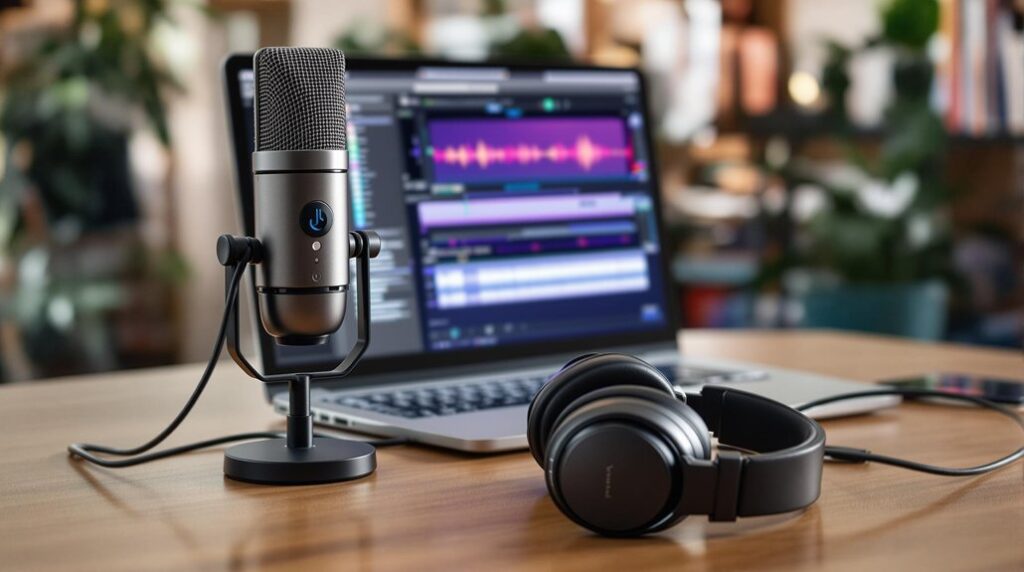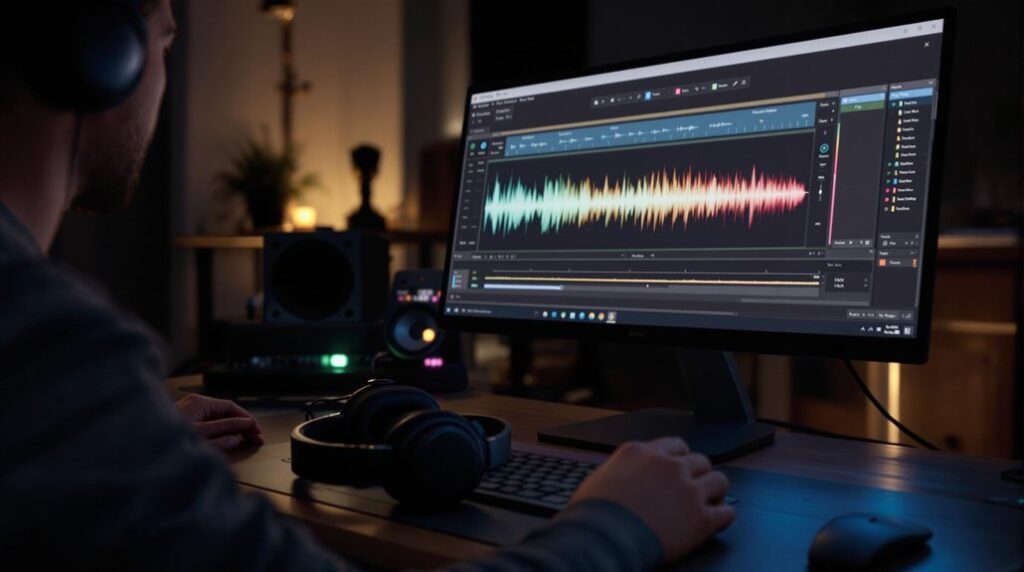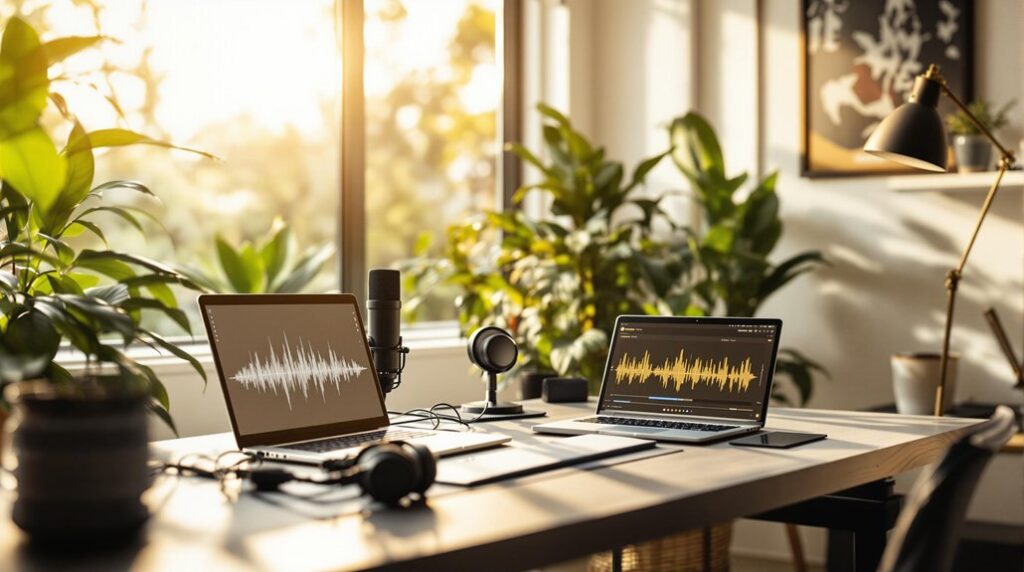To create a radio effect in Audacity, start by importing your audio track. Access the Equalization tool to adjust frequency levels, boosting around 1,000 Hz for clarity while dampening higher frequencies at 10,000 Hz. Preview your adjustments continually. Next, apply a high-pass filter with a cut-off frequency of 2,000 Hz and a 6 dB per octave slope. Review the filtered audio, making further adjustments as necessary. Compare your original and processed audio for clarity. Finally, enhance the sound with reverb and compression for added depth. Further exploration of effects may yield even richer audio quality.
Key Takeaways
- Import your audio files into Audacity by using the “File” > “Import” option or dragging them directly into the workspace.
- Apply Equalization to boost mid-range frequencies around 1,000 Hz and dampen higher frequencies for a clearer sound.
- Use a High-Pass Filter with a cut-off frequency of 2,000 Hz to remove low-end noise and enhance clarity.
- Regularly preview your adjustments to ensure you’re achieving the desired radio-like quality in your audio.
- Experiment with additional effects like reverb and compression to add depth and balance to your final mix.
Import Your Audio Track
To begin working with your audio in Audacity, launch the application and create a new project.
To import your audio track, navigate to the “File” menu, select “Import,” and then choose “Audio.” Locate and select your desired audio file, or for a more efficient process, simply drag and drop the file directly into the Audacity workspace.
Once the audio track is imported, confirm that it is selected to maintain focus on your desired audio before applying any effects. This step is important for achieving precise edits.
After importing, observe the waveform representation to confirm that the audio has been successfully imported and is ready for further processing, guaranteeing an excellent foundation for creating that “radio that’s” unmistakable sound. You can also utilize the selection tool for precise audio editing.
Click okay to proceed.
Access Equalization Tool
With your audio track successfully imported into Audacity, the next step involves enhancing its sound quality through equalization.
To access the Equalization tool, navigate to the ‘Effect’ menu at the top of the interface and select ‘Equalization’ from the drop-down list. This action opens the Equalization settings window, where you can apply various equalization techniques.
You may choose from preset options or create a custom curve by clicking ‘Manage’ and selecting ‘Add Curve’ for tailored adjustments.
To optimize the frequency response, you can amplify specific frequencies by dragging points to boost levels around 1,000 Hz while reducing levels at higher frequencies, such as 10,000 Hz. Understanding frequency spectrum management is essential for achieving a balanced mix.
Always preview your changes to guarantee the desired effect in audio mixing is achieved.
Adjust Frequency Levels
To achieve a compelling radio effect in Audacity, it is crucial to identify key frequencies that enhance vocal clarity and eliminate unwanted noise.
Adjusting the Equalization curve allows for targeted modifications, such as amplifying frequencies around 1,000 Hz while dampening those near 10,000 Hz. Utilizing EQ techniques for clarity can further improve your audio by ensuring that the vocal elements stand out in the mix.
Ongoing testing and refinement of these levels will guarantee peak audio quality and coherence in the final output.
Identify Key Frequencies
Achieving a radio-like voice effect in Audacity requires careful adjustment of key frequency levels. Focus on amplifying frequencies around 1,000 Hz by +12 dB to enhance clarity and presence, while dampening higher frequencies at 10,000 Hz by -12 dB to replicate the characteristic sound of AM radio. Implementing a high-pass filter with a cut-off frequency of 2,000 Hz will eliminate unwanted low-end noise, improving overall audio clarity. Employing these audio enhancement techniques, combined with frequency analysis, allows for a refined radio sound design.
| Frequency Range | Adjustment |
|---|---|
| 1,000 Hz | +12 dB |
| 10,000 Hz | -12 dB |
| Below 2,000 Hz | High-pass filter |
| Overall Clarity | Improved |
| Voice Presence | Enhanced |
Adjust Equalization Curve
Adjusting the equalization curve in Audacity is an essential step in sculpting the desired radio-like sound of your audio track.
Utilizing effective equalization techniques, you can manipulate the frequency response to enhance audio clarity. Start by accessing the Equalization effect, creating a custom curve that amplifies frequencies around 1,000 Hz by +12 dB, which considerably enhances vocal presence.
Concurrently, reduce frequencies at 10,000 Hz by -12 dB to eliminate unwanted high-end noise, further refining the radio effect. After applying these adjustments, visualize the waveform size increase to confirm the impact of your changes.
Always preview your modifications to verify the adjustments effectively achieve the intended audio enhancement before finalizing your settings.
Test and Refine Levels
Refining audio levels is a critical process in achieving the desired radio effect in your track.
Begin by applying Equalization in Audacity: amplify frequencies around 1,000 Hz by +12 dB to enhance vocal clarity, while dampening higher frequencies at 10,000 Hz by -12 dB to reduce unnecessary brightness.
Following this, utilize a high-pass filter with a 6 dB slope and a cut-off frequency of 2,000 Hz to eliminate excess low-end noise.
It is essential to test audio quality after each adjustment, allowing for immediate evaluation of sound clarity.
Iterating on these processes and incorporating listener feedback will further refine the audio, ensuring an ideal radio-like quality in your final mix.
Preview Equalization Changes
To evaluate your modifications, begin by selecting the track and managing to the Effect menu, then choose Equalization to access the settings window.
Here, you can adjust the frequency curve, amplifying or dampening specific frequencies as needed.
Once you’ve made your adjustments, utilize the “Preview” button to listen to the audio with the applied changes.
This step is essential for understanding the preview benefits, as it allows you to apply effective listening techniques to gauge the overall audio clarity.
Incorporating critical listening during this process is crucial for detecting resonant tones and refining your EQ adjustments.
Continuously tweak the Equalization settings and re-preview until you achieve the desired radio-like quality, ensuring that each adjustment enhances the intended sound effect.
Apply High-Pass Filter
Applying a high-pass filter in Audacity is an effective method for enhancing audio clarity by eliminating unwanted low-frequency noise.
To execute this, navigate to the “Effects” menu and select “High-Pass Filter.” Implement high pass filter techniques by setting an appropriate cut-off frequency, such as 2,000 Hz, which reduces low-end interference while preserving vocal integrity.
A slope of 6 dB per octave is recommended for a gradual roll-off, ensuring that the overall audio quality remains intact. Conduct thorough frequency response analysis by previewing the changes to evaluate clarity and make necessary adjustments.
For best results, consider repeating the high-pass filter application after modifying equalization settings, enhancing the desired radio-like voice effect. Additionally, maintaining a balance between reverb settings and clarity is crucial to achieving a polished final mix.
Set Cut-Off Frequency
Setting the cut-off frequency is a pivotal step in achieving a polished audio result when using the high-pass filter in Audacity. For ideal performance, it is recommended to set the cut-off frequency at 2,000 Hz. This effectively eliminates low-frequency noise while preserving vocal clarity, aligning with sound design principles.
Employing a 6 dB slope guarantees a gradual change, minimizing abrupt alterations in audio quality. The adjustable filter settings in Audacity allow for real-time previews, facilitating precise audio processing techniques.
It is essential to engage in iterative testing to fine-tune this parameter, guaranteeing that the desired radio effect is achieved without compromising essential vocal characteristics. The cut-off frequency is integral to shaping the final sound in digital filter applications.
Review Filtered Audio
Evaluating the filtered audio is essential to confirm that the desired radio effect has been effectively achieved.
This review process allows you to ascertain ideal filtered audio quality and make necessary adjustments.
Consider the following steps:
- Conduct a clarity assessment by comparing the processed audio with the original.
- Examine the waveform size to visually confirm the impact of the Equalization.
- Identify any remaining noise that may require further refinement.
Repeat Adjustments as Needed
To achieve the desired radio effect, refining frequency settings through iterative adjustments is essential.
Continuously evaluate audio clarity to determine the effectiveness of each modification and guarantee an ideal sound quality.
If necessary, repeat the Equalization and high-pass filter processes, making precise alterations to enhance the overall audio characteristics. Utilizing subtractive EQ techniques can significantly improve clarity and reduce muddiness in your audio mix.
Fine-tune Frequency Settings
How can one achieve the ideal radio effect in Audacity through meticulous frequency adjustments?
Fine-tuning frequency settings is essential for crafting a convincing radio voice, and this process involves several key steps:
- Amplify frequencies around 1,000 Hz by +12 dB to enhance vocal clarity and improve audio dynamics.
- Apply a high-pass filter with a cut-off frequency at 2,000 Hz to eliminate low-frequency noise, thereby enhancing sound layering and overall clarity.
- After evaluating the audio quality, dampen harsh frequencies at 10,000 Hz by -12 dB to create a smoother sound.
Iteratively refine these settings, regularly previewing the adjustments to verify that each change contributes positively to the radio-like quality of your audio.
Evaluate Audio Clarity
What methods can be employed to guarantee audio clarity in your project after applying the initial adjustments? Conducting a thorough audio quality assessment is essential.
First, listen closely to the audio after applying Equalization and the high-pass filter. If the expected radio-like quality is missing, adjust the frequency boosts and cuts accordingly.
Reapplying the high-pass filter may further enhance clarity by eliminating residual low-frequency noise. Utilize the preview function to hear immediate effects of your modifications, allowing for precise adjustments.
Additionally, compare the processed audio with the original track to evaluate the effectiveness of your sound engineering techniques. Implementing these radio broadcasting tips will secure significant improvements in clarity and a successful radio effect in your project.
Compare Original and Processed
When comparing the original audio sample to the processed version, the most noticeable difference lies in the frequency response and overall tonal quality.
This audio quality analysis reveals distinct characteristics:
- Frequency Range Evaluation: The original maintains a full frequency range, while the processed audio emphasizes mid-range frequencies around 1,000 Hz.
- Tonal Quality Shift: Processed audio exhibits a tinny quality, akin to AM radio, contrasting with the richer tone of the original recording.
- Noise Reduction: The high-pass filter reduces frequencies above 10,000 Hz, enhancing clarity and emphasizing the radio-like effect.
This original sound comparison underscores the impact of processing on audio fidelity, demonstrating how specific adjustments create a compelling radio simulation. Additionally, understanding the concept of reverb’s origins can help producers appreciate how effects shape audio characteristics.
Explore Additional Effects
Building on the comparison between the original and processed audio, further enhancements can be achieved through the application of various effects that augment the radio simulation.
Incorporating reverb effects can add depth and a sense of space, considerably enhancing the audio’s radio-like quality. Additionally, employing compression techniques will help even out volume levels, making quieter sounds more audible while preventing distortion in louder segments.
Distortion usage, when applied sparingly, can emulate the warmth and character associated with vintage radio broadcasts, enriching the vocal presence. For a more dynamic sound, consider adding a delay effect to replicate the echo often heard in radio environments.
Finally, adjusting the overall mix with background music or sound effects can create a more immersive listening experience. Additionally, applying EQ to reverb can further tailor the reverb’s tone to fit the desired radio effect, preventing muddiness in the mix.
Frequently Asked Questions
How to Make a Radio Effect in Audacity?
To create a radio effect in Audacity, enhance sound quality by utilizing audio filters like equalization and high-pass filters. These techniques effectively modulate voice frequencies, resulting in a distinct, radio-like audio output.
How Do You Make a Stereo Effect in Audacity?
To achieve a stereo effect in Audacity, utilize audio panning methods by adjusting track positions, apply stereo widening techniques for enhanced depth, and incorporate sound spatialization tips to create a balanced and immersive listening experience.
How to Add Walkie Talkie Effect in Audacity?
To achieve a walkie-talkie effect in Audacity, apply a walkie talkie filter through voice modulation, enhance mid-range frequencies, and incorporate sound distortion. This process simulates the characteristic audio limitations and gritty transmission quality of walkie-talkies.
How Do I Add a Radio Effect to a Song?
To add a vintage sound reminiscent of radio broadcasts, apply audio distortion techniques alongside voice modulation. Utilize equalization and filtering to emphasize mid-range frequencies, ensuring the result captures the essence of classic radio transmission quality.
Conclusion
In summary, creating a radio effect in Audacity involves a systematic approach that encompasses importing audio, utilizing equalization tools, and applying filters. Each step, from adjusting frequency levels to reviewing filtered audio, contributes to the final output’s authenticity. The iterative process of refining adjustments guarantees ideal results. Additionally, comparing the original and processed audio enhances understanding of the effect’s impact. Exploring additional effects can also enrich the audio experience, offering avenues for creative experimentation.




